You come to the affiliate world expecting to increase sales and raise brand awareness. You plan everything, from promotional platforms to affiliate commissions. But how do you know whether your strategy is generating a good result? Does it meet your goals? Is your affiliate’s performance effective?
To find answers to these questions, get to know realistic, measurable goals and evaluations. That’s where affiliate marketing metrics come into play.
This guide will explain what affiliate marketing metrics are and why they matter for your campaign’s success. We also list the 20 affiliate marketing metrics to keep an eye on and show you how to track them effectively.
Here’s a quick overview of the metrics you should track to assess your affiliate sales program’s success:
- Total traffic referred
- Clicks
- Click-through rate (CTR)
- Conversion rates (CR)
- Earnings per click (EPC)
- Cost per lead (CPL)
- Cost per sale (CPS)
- Sales per affiliate
- Affiliate revenue
- Average order value (AOV)
- Number of new affiliates
- Percentage of active affiliates
- Top affiliates
- Top products
- Number of new customers
- New vs. recurring customer ratio
- Customer retention rate
- Customer lifetime value (CLV)
- Profit margin
- Return on investment (ROI)
To track your affiliate campaign effectively, you need reliable affiliate tracker. Without it, managing affiliates manually takes too much time, leads to messy data, and makes it harder to improve your campaign.
Looking for a trusted solution? Check out UpPromote—the top trusted Shopify affiliate solution for growth, with 4.9/5 rating and over 4,000 positive reviews. It offers powerful tracking methods and in-depth reports to help you understand and grow your program more efficiently.
Stay on top with real-time tracking & reports on affiliate performance for better optimization with UpPromote.
What Are Affiliate Marketing Metrics?
Affiliate marketing metrics are measurable data points used to assess the performance and success of an affiliate marketing program. They provide insights into traffic, conversions, revenue, and overall effectiveness.
Don’t confuse metrics and KPIs (key performance indicators) when starting an affiliate program. They’re related but not quite the same.
Here’s how they differ:
- Metrics are the general numbers you track daily, like website visits, revenue, or order counts. They give you a broad picture of what’s happening in your business, but they don’t automatically show success or failure.
- KPIs, on the other hand, are specific metrics tied directly to your goals. KPIs indicate performance and success based on strategic priorities. For example, while “number of new users” is a metric, a KPI might be “new customer growth rate of 10% per month.”
In short, every KPI is a metric, but not every metric is a KPI. KPIs focus on what truly matters for business growth and success, while metrics provide a broader set of data that may or may not be critical. KPIs are chosen based on company goals, while metrics are used for overall monitoring and analysis.
Top 20 Key Affiliate Marketing Metrics You Should Know
You can track many metrics to get a broad view of how your affiliate program is performing, but not all of them are equally important.
The key metrics—such as affiliate traffic, number of affiliate sales, and affiliate revenue—form the basis for setting your KPIs.
So, prioritize what truly matters to evaluate your program’s effectiveness and identify areas for improvement.
Here’s a list of the most important affiliate marketing metrics you should focus on:
1. Total Traffic Referred
One key metric to track is the total referred traffic—the number of visitors affiliate partners send to your site.
This metric gives you a big-picture view of the affiliate program’s reach and helps pinpoint which affiliates or strategies drive the most visitors.
More traffic is a good sign, but if conversions and sales stay low, it’s worth digging deeper to see what’s working and what’s not.
2. Clicks
Another one to track is clicks—the number of times people click on an affiliate link, whether it’s on a blog, email, or social media post.
Clicks show how engaging an affiliate’s promotion is. A high click count shows strong interest. But if sales are low, it might mean there are tracking issues or that the product doesn’t match the audience.
3. Click-Through Rate (CTR)
Click-through rate (CTR) is an essential and fundamental metric that measures the percentage of people who click on your affiliate link after seeing it.
Here’s how to calculate it:
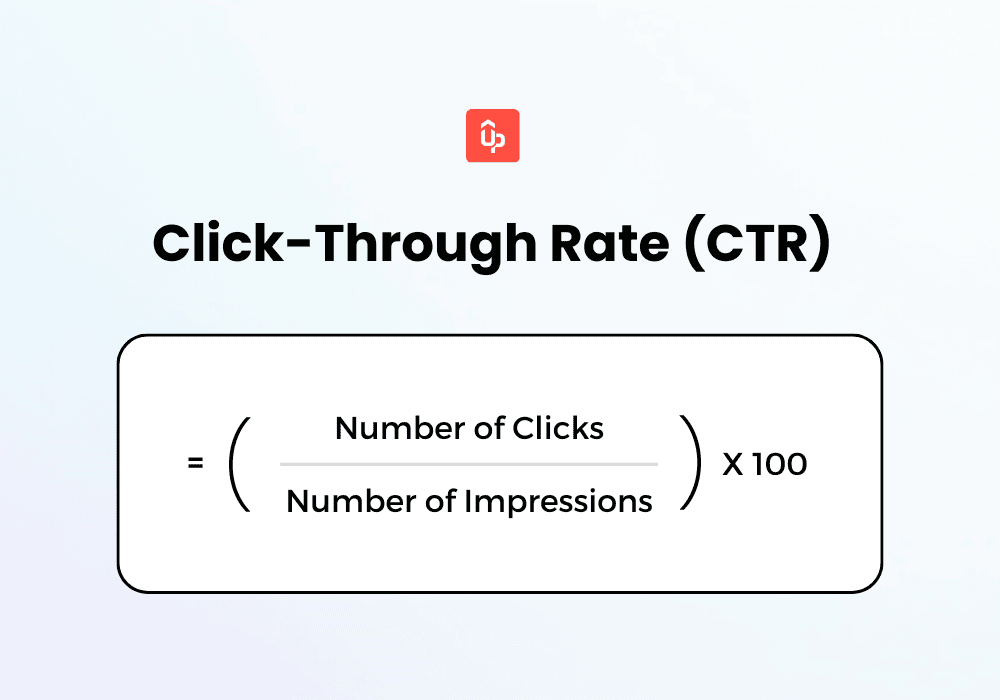
In there:
- Number of Clicks: The total number of clicks on an affiliate’s promotional link or ad.
- Number of Impressions: The total number of times the affiliate’s link or ad appeared on users’ screens.
CTR shows how well an affiliate’s promotions work.
A high CTR means the affiliate’s promotions are engaging and convincing enough to get people to take action. If more people click the link, there’s a greater chance of driving traffic, generating leads, and increasing sales.
For affiliates, tracking and improving CTR is key. Improving ad placement, messaging, and audience targeting can raise CTR. This can lead to better results and higher earnings.
4. Conversion Rates (CR)
In affiliate marketing, the conversion rate (CR) measures the percentage of visitors who complete a desired action after clicking an affiliate link. This could be making a purchase, signing up for a service, or filling out a form.
The formula for Conversion rate in affiliate marketing is:
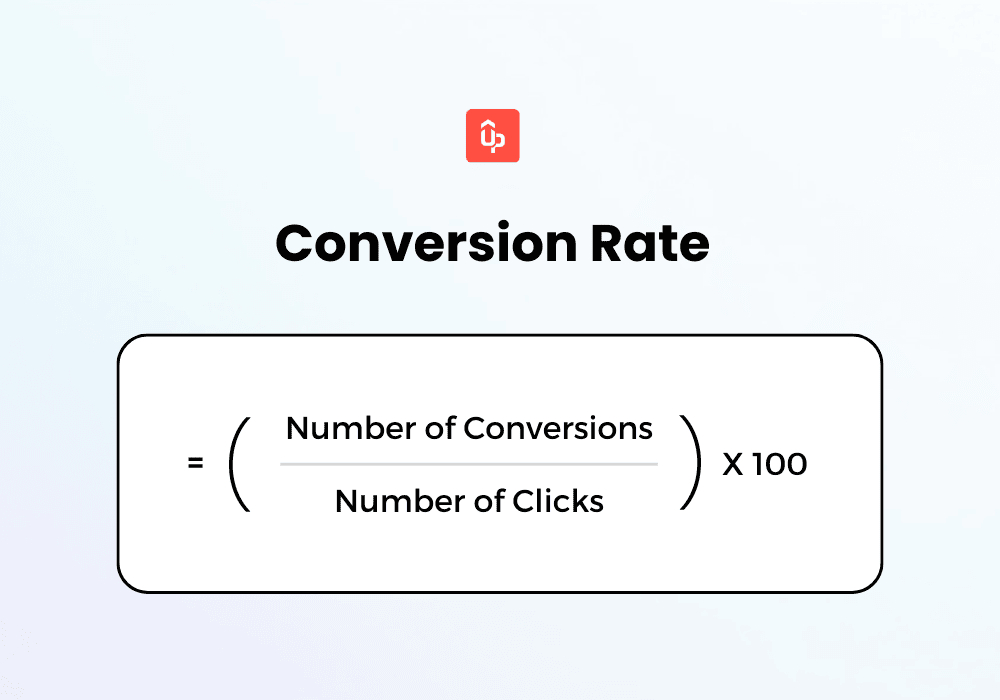
For example, 1,000 referred audiences visit your webinar platform, and 20 of them make a subscription. You’ll get a conversion rate of 2%.
This metric can tell how effective your marketing strategy and your products’ relevance. It can also indicate the quality of the traffic. From there, you can understand which channels bring in the most qualified visitors and invest your resources accordingly.
5. Earnings Per Click (EPC)
Earnings Per Click (EPC) in affiliate marketing KPI calculates the average earnings per click on an affiliate’s link or ad. This is one of the key indicators used to measure the performance and profitability of your campaign.
You can calculate EPC using this formula:
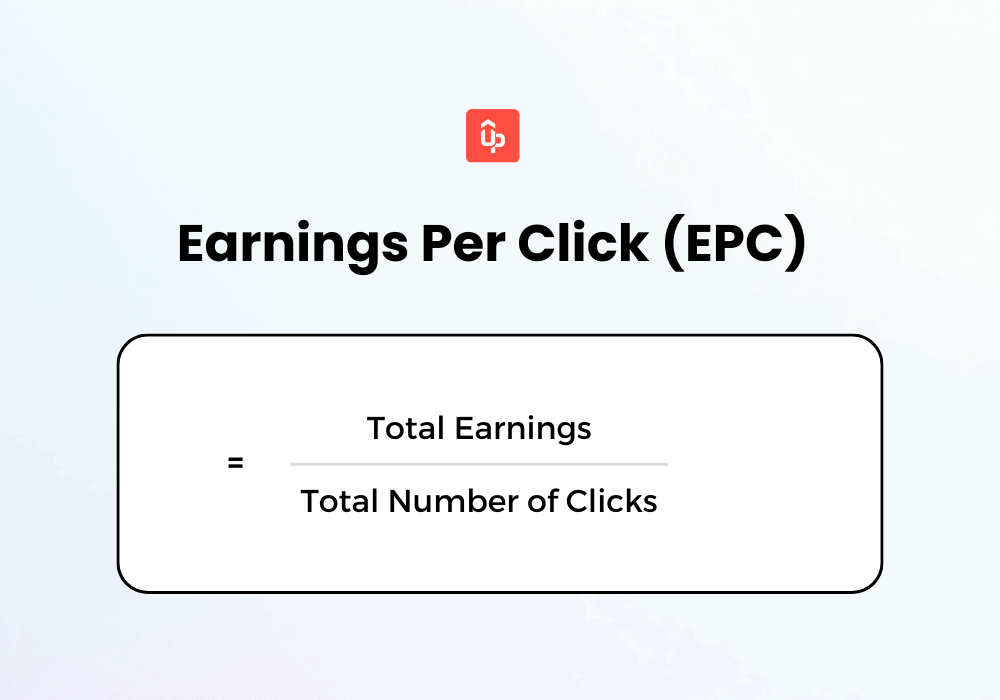
6. Cost per Lead (CPL)
Cost Per Lead (CPL) is a key metric in affiliate marketing and digital advertising that helps measure how cost-effective your lead generation strategies and efforts are. It tells you how much you’re spending to gain a single lead, giving you a clear picture of your campaign’s efficiency.
To calculate CPL, use this formula:
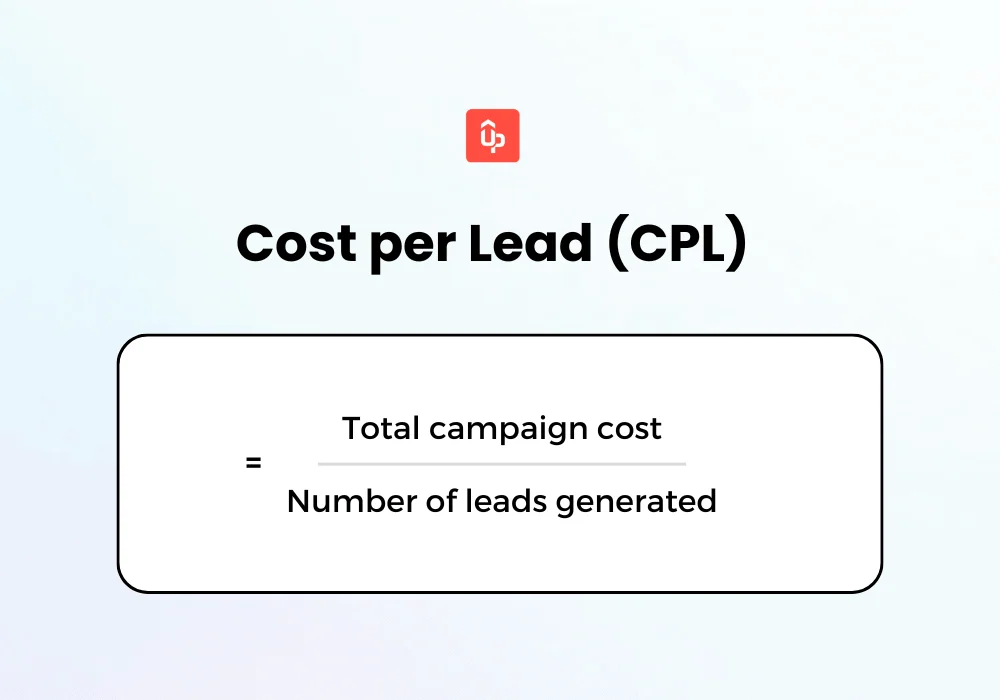
Depending on the program goals, the leads could be email signups, form filling, trial subscriptions, etc.
Business owners can use CPL to optimize their strategies. This may involve refining promotional materials, targeting specific audience segments, or identifying the most effective affiliate partnerships.
7. Cost per Sale (CPS)
The cost per sale (CPS) indicates how much you pay for each completed sale generated through the affiliate links.
Here’s how you can calculate it:
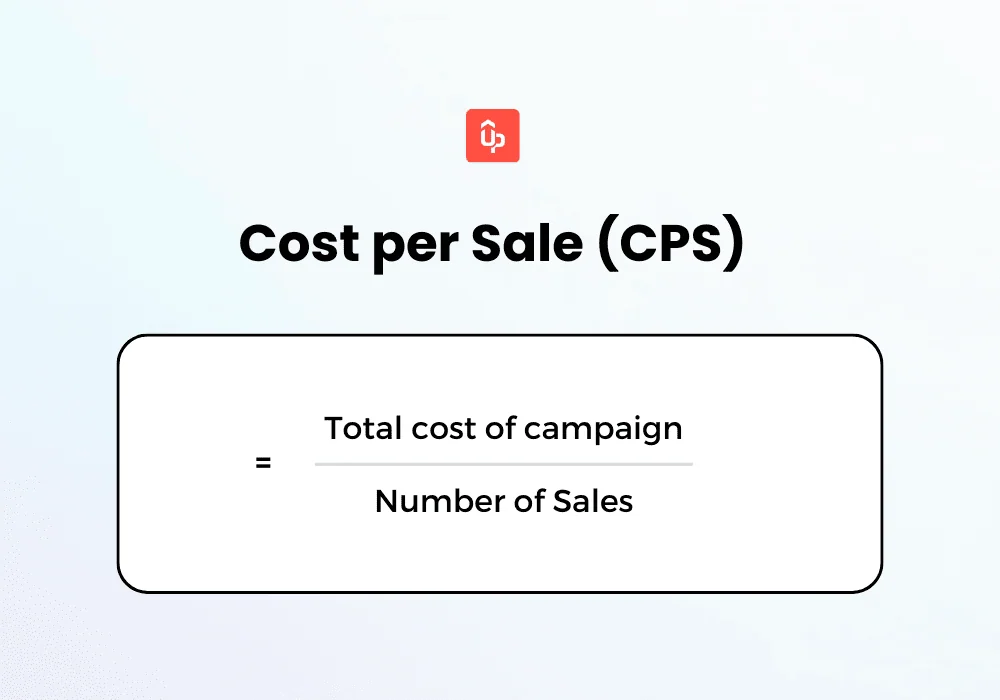
The Cost Per Sale (CPS) directly connects your affiliate program expenses to actual sales made, helping you evaluate its efficiency and profitability.
A low CPS combined with high sales indicates a cost-effective and successful campaign. Use the insights to find which campaigns bring in sales at a lower cost. Then, allocate budgets more wisely.
8. Sales per Affiliate
This metric helps you understand how many sales each affiliate is generating for your brand.
From there, you can determine:
- Which affiliates consistently bring in the most customers
- Which affiliates have potential but may need more support
- Which affiliates aren’t active and haven’t generated sales for a certain period
Keeping track of each affiliate’s sales over a given timeframe provides a clear point of comparison. This way, you can reward top affiliates and identify trends in their sales. If you notice any changes, you can dig deeper to understand what’s causing them.
9. Affiliate Revenue
Affiliate revenue is the total income your business earns through an affiliate program.
It’s a key indicator of how well your program drives sales and contributes to overall revenue. By comparing affiliate revenue to program costs (commissions, platform fees, marketing materials, etc.), you can measure your return on investment (ROI) and assess profitability.
Tracking this revenue helps you decide where to allocate your budget. If your program is a strong revenue driver, it makes sense to invest more in it.
Affiliate revenue also gives valuable insights into what’s working. From there, you can shape future marketing campaigns, product decisions, and overall business growth.
10. Average Order Value (AOV)
Average order value (AOV) refers to the average amount customers spend per transaction through an affiliate’s referral link.
The formula for average order value in affiliate marketing is:
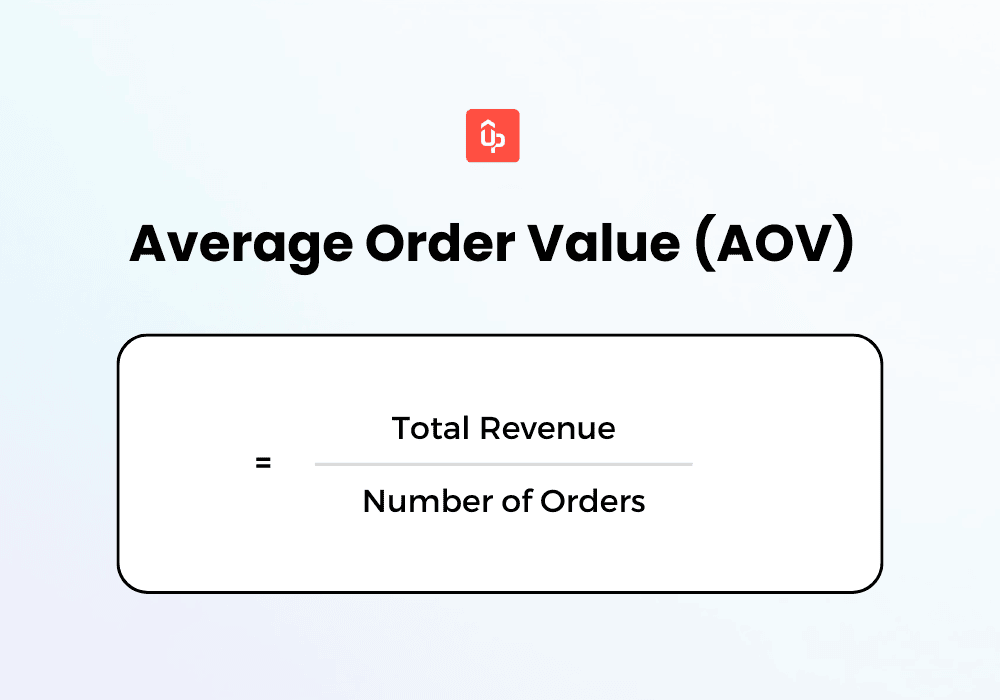
AOV helps you understand the buying behavior of customers referred by affiliates.
A higher AOV often means your partners reach the right audience. It also shows that your products or offers are attractive enough for larger purchases.
But if your AOV is lower than you’d like, it might be time to rethink your promotion strategy. You can work with affiliates to highlight higher-priced products, offer product bundles, or promote add-ons to increase order value.
Analyzing AOV can reveal opportunities for upselling and cross-selling. If some affiliates consistently bring in higher AOVs, take a closer look at how they promote your products—you might find useful strategies to share with others.
Increasing AOV directly impacts profitability. Even a slight boost can significantly improve your profit margins without increasing marketing spend or acquiring more customers.
11. Number of New Affiliates
Keeping track of how many new affiliates join your program over a certain period is important. This metric shows how well your program is growing and helps you assess whether your recruitment and promotional efforts are working.
A steady increase in signups is a great sign. It means your program is attracting interest and expanding its reach. More affiliates bring fresh audiences, new marketing strategies, and different promotional channels.
On the other hand, if signups are low, it might be time to improve how you promote your program or refine your recruitment strategy.
But here’s something to keep in mind:
- Having more affiliates means you need to put in more effort. You’ll need to onboard, train, and support them. This way, they’ll understand your products and promote them effectively.
- Having a large affiliate network is good, but the real value lies in partnering with those who match your brand and deliver real results. Focus on building strong, lasting relationships with reliable affiliates that contribute to your program’s success.
12. Percentage of Active Affiliates
This metric shows how many of your affiliates are actively promoting your products or services.
A high percentage of active affiliates means your program is doing well at keeping partners engaged and motivated. Factors like competitive commission rates, quality products, strong support, or appealing incentives can encourage affiliates to stay involved and consistently promote your brand.
If you notice a drop in active affiliates, it’s worth looking into what might be holding them back. Are they facing challenges with promotions? Do they need better marketing materials or extra incentives? Making small improvements—like offering bonuses or providing better affiliate assets—can help re-engage affiliates and boost their activity.
13. Top Affiliates
Top affiliates are the partners who bring the most value to your business within a given period. This value can be measured in various ways, typically by revenue generated, number of sales, or leads driven.
Identifying your top affiliates is essential for several reasons:
- Gain performance insights: Analyzing top affiliates’ strategies reveals effective practices. Sharing these insights can guide other partners to success.
- Build relationships: When you recognize and reward top affiliates, it motivates them to perform better. This also sets a good example for others.
- Optimize your program: Knowing what drives success helps you refine commission structures, enhance marketing materials, and more.
- Explore strategic collaborations: Your best performers can turn into long-term allies. They can work with you on joint ventures, co-branded campaigns, or special product promotions. This way, you can use their influence and reach effectively.
Using UpPromote, you can quickly determine which affiliates bring the highest referral orders and sales to your brand in the Top Affiliates tab within the Analytics dashboard.

From there, you can easily reward them to encourage even better results. With just a few clicks, you can set up clear rules and conditions for bonuses using UpPromote’s Bonus feature.
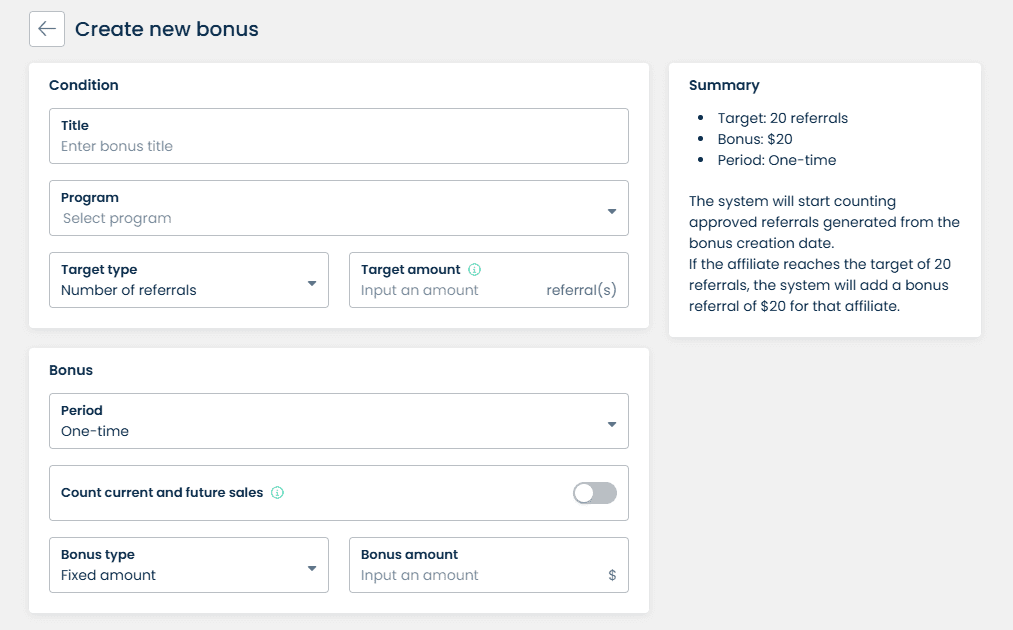
Join 115,000+ UpPromote users to customize dynamic incentives and boost affiliate engagement.
14. Top Products
Tracking this data will show you the specific items that generate the highest performance within your affiliate program. This performance can be measured by various metrics, such as the number of sales or revenue generated.
Spotting your top products in your affiliate campaign helps make it more efficient. By analyzing this metric, you are able to:
- Concentrate your marketing efforts and resources on products that already sell well, maximizing results.
- You can strategically adjust your commission rates for products that are harder to sell or have higher profit margins. Higher commissions can motivate affiliates to promote these products more.
- Provide your affiliates with high-quality marketing materials specifically designed for your best-seller items. Giving your partners good resources boosts their chances of turning clicks into sales.
- Identify trends and opportunities. If a product suddenly takes off, it might signal a growing demand you can capitalize on.
In UpPromote’s Analytics section, the Product Analytics tab shows you which products are most popular.
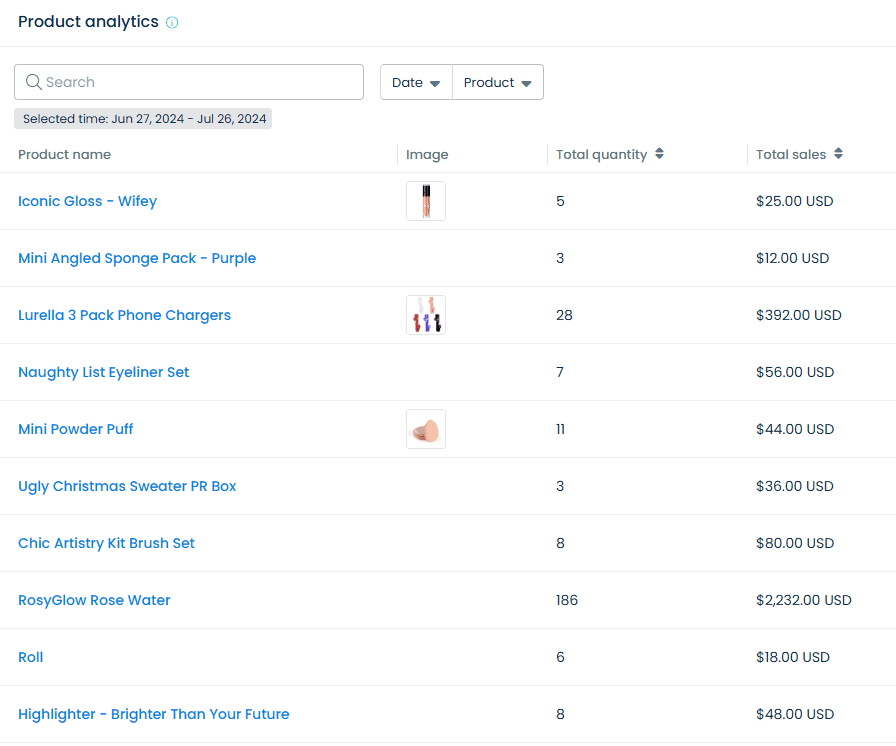
With this information in hand, you can adjust your strategies to boost sales. For instance:
- Launch separate campaigns with smart commission rates for your best-selling products.
- Bundle items together to encourage customers to buy more.
- Offer exclusive deals to motivate more purchases.
With UpPromote, you can easily set special commission rates for specific products or collections. You can set higher commissions for items you want to promote more. For products with tighter margins, you can lower the commissions.
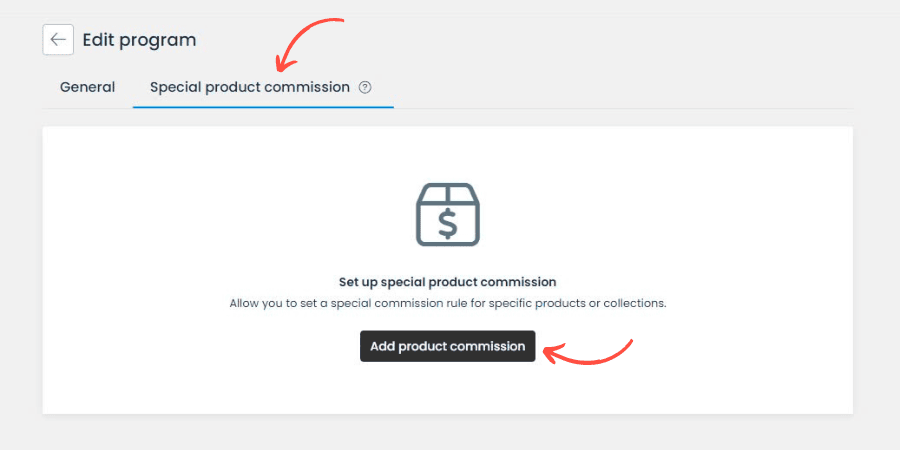
Then, simply select the individual products or entire collections you want to focus on and set the commission rates you prefer to offer.
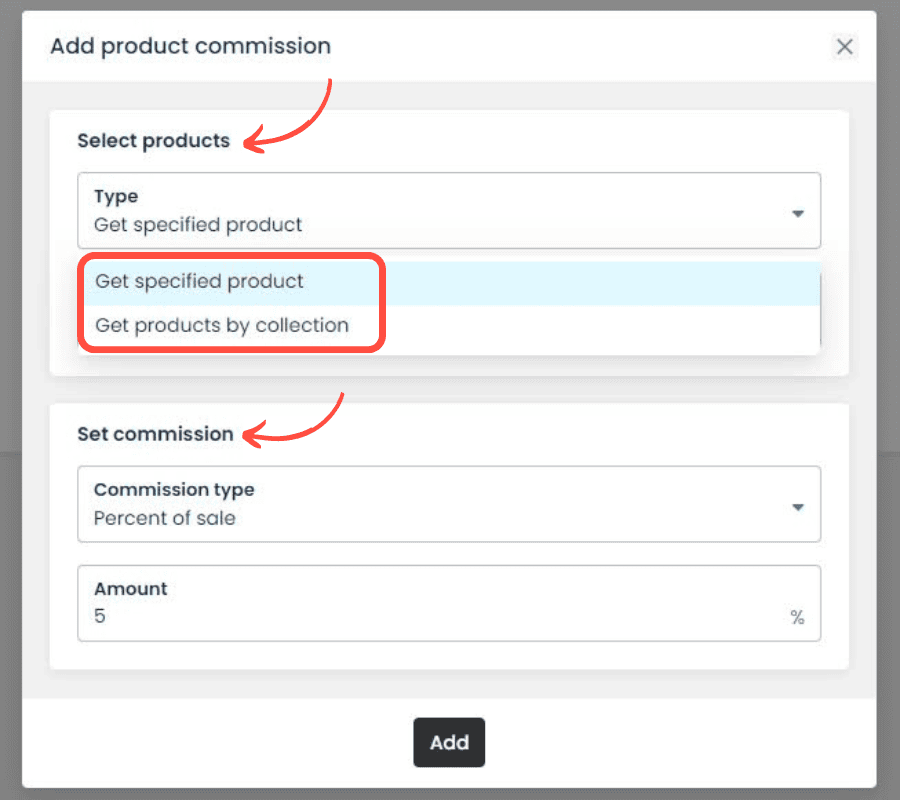
Set a lucrative commission rate for your special items with UpPromote and attract affiliate marketers eager to promote them.
15. Number of New Customers
In affiliate marketing, new customers are first-time buyers or leads that affiliates bring to your business within a set time. This metric helps you see how well your program is attracting fresh customers, not just driving repeat sales.
A successful affiliate program should keep bringing in new customers, helping your business grow. By tracking this, you can spot which affiliates are best at reaching new buyers and which ones focus more on existing customers. This insight helps you fine-tune your affiliate marketing strategies to get the best results.
You can also compare how many new customers come from affiliates versus other channels like paid ads, social media, or email marketing. This way, you’ll know where your efforts pay off the most.
Note: This number is important, but it’s just one piece of the puzzle. To get a clearer picture, also consider how valuable these new customers are over time and whether they stick around.
16. New vs. Recurring Customer Ratio
This metric helps you know the proportion of first-time buyers compared to returning customers referred by affiliates.
By looking at this ratio, you can:
- Assessing affiliate program sustainability: A strong affiliate program should bring in new customers while also keeping existing ones coming back. If most referrals are new buyers, affiliates may drive one-time sales rather than long-term customers. A balanced mix means they’re also helping with customer retention.
- Optimizing affiliate strategies: If affiliates mostly attract new customers, you might encourage them to promote products or services that lead to repeat purchases, like subscriptions or loyalty programs.
- Understanding customer behavior: The ratio provides insights into customer behavior and purchasing patterns. A low ratio of recurring customers might suggest issues with product quality, customer service, or overall customer experience.
17. Customer Retention Rate
The customer retention rate measures the percentage of affiliate-referred customers who continue to engage with and make purchases from the advertiser. This metric is crucial for evaluating the ability of the affiliate marketing program to cultivate a loyal customer base.
To calculate the retention rate, use the following formula:
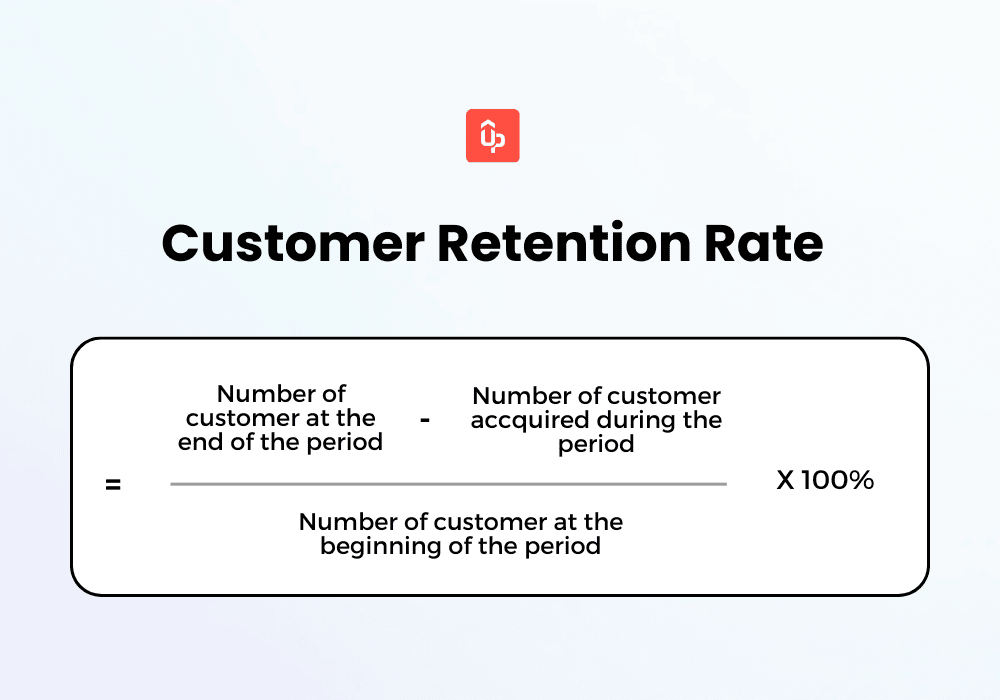
By understanding this metric, you can optimize your marketing strategies to better target affiliate-referred customers with personalized offers and promotions that encourage repeat purchases.
And if your campaign generates a high retention rate, that would be perfect! Your customers are satisfied with your offerings.
18. Customer Lifetime Value (CLV)
Customer Lifetime Value (CLV) in affiliate marketing represents the total revenue you can reasonably expect from a single customer acquired through your affiliate program over the entire duration of their relationship with your business. It’s a crucial metric because it shifts the focus from individual transactions to the long-term value of each customer.
Here’s how you measure it:
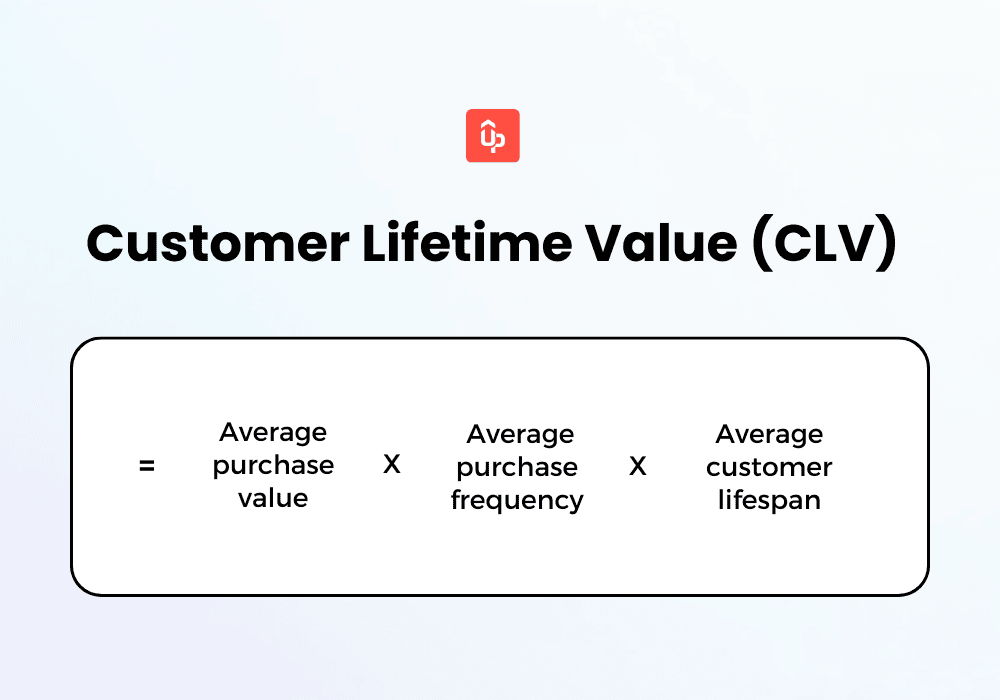
Where:
- Average purchase value: The average amount a customer spends per transaction.
- Average purchase frequency: How often a customer makes a purchase.
- Average customer lifespan: The average length of time a customer remains a paying customer.
A good CLV depends on your niche and product type. Understanding this metric helps you determine how much you should invest in acquiring new customers based on the long-term value they bring to your business.
19. Profit Margin
Profit margin in affiliate marketing refers to the percentage of revenue that remains after deducting all costs associated with the affiliate program, including commissions paid to affiliates, software fees, marketing materials, and bonuses. It represents the actual profit earned from affiliate-driven sales.
However, it’s important to distinguish this from your overall business profit margin, as it specifically measures the profitability of your affiliate efforts.
Here’s its formula:
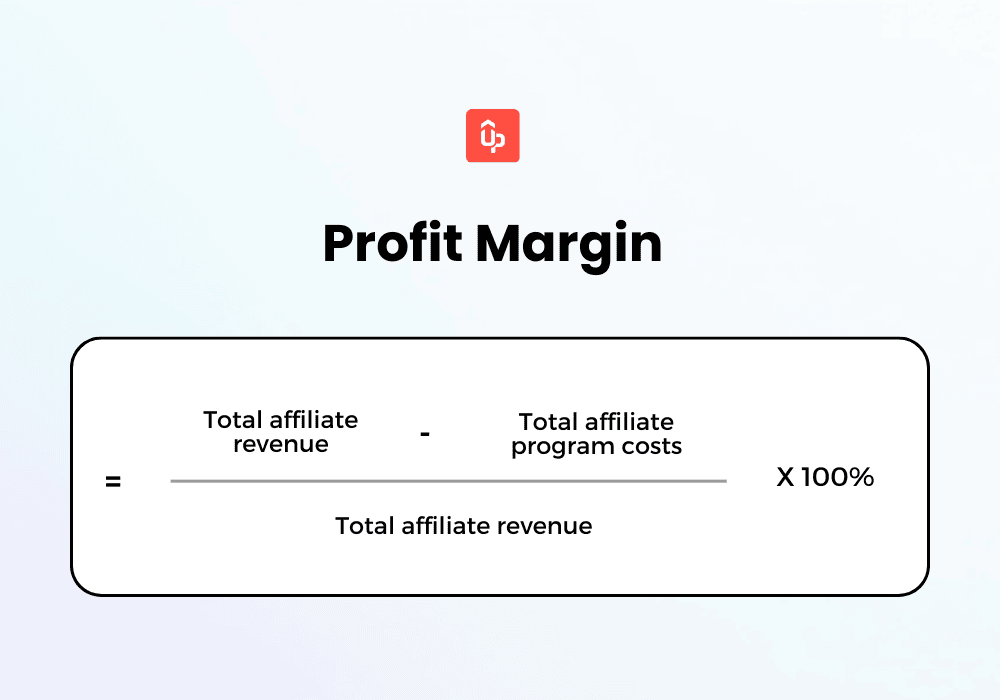
This ratio helps you assess whether your investment in affiliate marketing is generating a satisfactory return. You can use it to allocate resources and adjust budgets more effectively. If your profit margin is too low, it might indicate that your commission rates are too high or that other program-related costs need optimization.
20. Return on Investment (ROI)
Return on Investment (ROI) in affiliate marketing measures the profitability of your affiliate program by comparing the revenue generated to the total costs invested. It’s a crucial metric for evaluating the effectiveness and efficiency of your affiliate marketing efforts. It tells you how much profit you’re making for every dollar you spend on your affiliate program.
The formula for calculating ROI in affiliate marketing is:

A positive ROI means your affiliate program brings in more revenue than what you put into it, making it a success. A negative ROI suggests the earnings didn’t cover the investment, leading to a loss.
Tracking ROI helps you make smarter budget decisions. It shows whether your program generates real value and highlights areas where you can optimize for better returns.
How to Track and Measure Affiliate Marketing Metrics Effectively
Tracking and measuring affiliate marketing metrics requires a combination of tools, strategies, and consistent monitoring.
Consider the following ways to do it effectively:
Have Clear Affiliate Marketing Goals
Before diving into the affiliate marketing metrics, define your objectives.
Are you aiming to:
- Broaden your customer base?
- Generate leads?
- Or boost sales?
Follow the SMART model—Specific, Measurable, Achievable, Relevant, and Time-bound—to keep your goals clear and actionable.
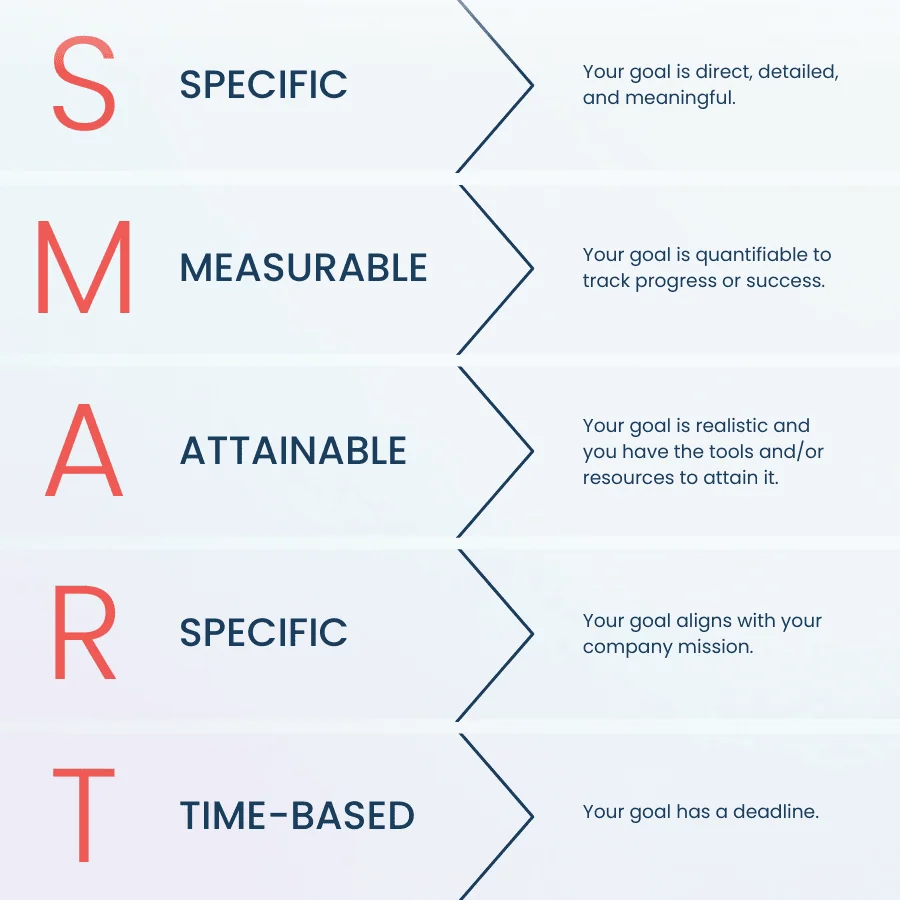
For example:
| Overall goals | SMART goals |
| Reach more customers | Raise international customer purchases by X% in 6 months by partnering with Y affiliates in new target regions. |
| Get more leads | Boost free trial sign-ups by X% in 3 months by teaming up with Y bloggers and review sites. |
| Increase sales | Aim for X% sales growth in 4 months by collaborating with Y influencers. |
While countless metrics can be tracked, achieving your goals requires focusing on just a few key metrics that align with your aims. If your goal is to increase sales, focus on metrics like conversion rates, average order value, or sales per affiliate. These become the foundation for setting vital KPIs and actionable steps to drive results.
When you have well-defined goals, you can take a better approach to measurement and build effective communication with your affiliate team, as the predefined metrics guide everyone toward the same objectives, increasing the chance of success.
Track Affiliate Performance Closely with Affiliate Software
To understand how well your affiliate program is meeting its goals and KPIs, a reliable affiliate marketing app with robust tracking capabilities is key. It lets you gather real-time insights into your affiliates’ performance accurately, enabling better analysis and optimization later on.
With UpPromote, the app automatically generates unique affiliate links, making it easy for you to track the sales each partner brings in.
But that’s not all—UpPromote offers multiple tracking methods to fit your needs. You can track affiliate-driven sales through:
- Coupon codes
- Connected customers
- Connected products or collections
Whenever a sale is made, you can check the Referrals tab to see where the referral came from.
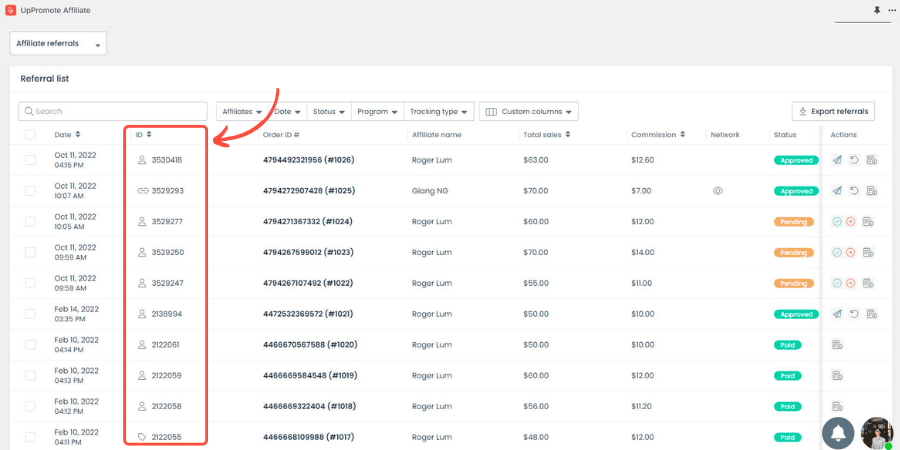
In addition, UpPromote provides the option to add UTM parameters to affiliate links, allowing you to track data in Google Analytics.
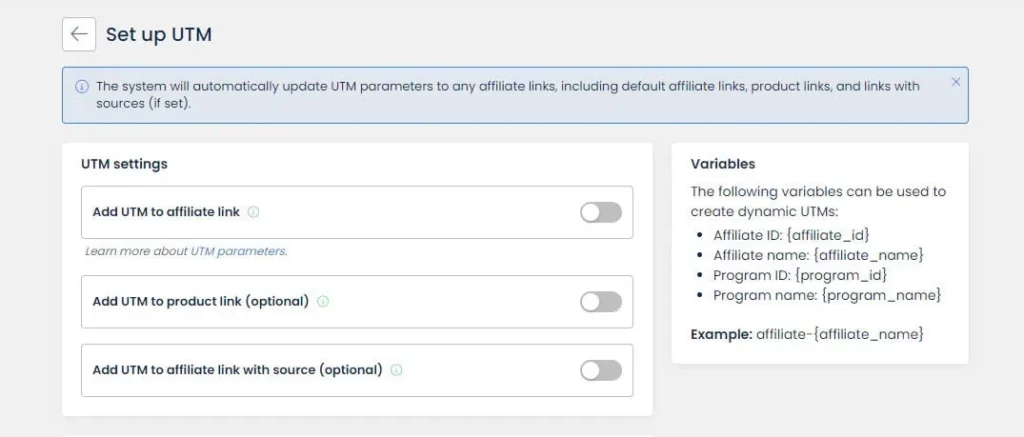
Analyze and Optimize Affiliate Campaigns Based on Data
Only tracking affiliate performance is not enough. The next important thing is to analyze the data and see what works and what doesn’t. The goal is to improve your affiliate campaign for better results.
With UpPromote, you can easily get real-time, detailed reports and analytics on your affiliates’ contributions to your program. You can check key numbers like total affiliates, orders, sales, clicks, and commissions, all displayed in easy-to-read charts.
The Top Affiliates and Product Analytics tabs help you dig deeper to spot your best affiliates and find out which products sell the most.
UpPromote also allows you to download reports in different formats—Excel, CSV, and PDF—so you can compare and review them more easily.
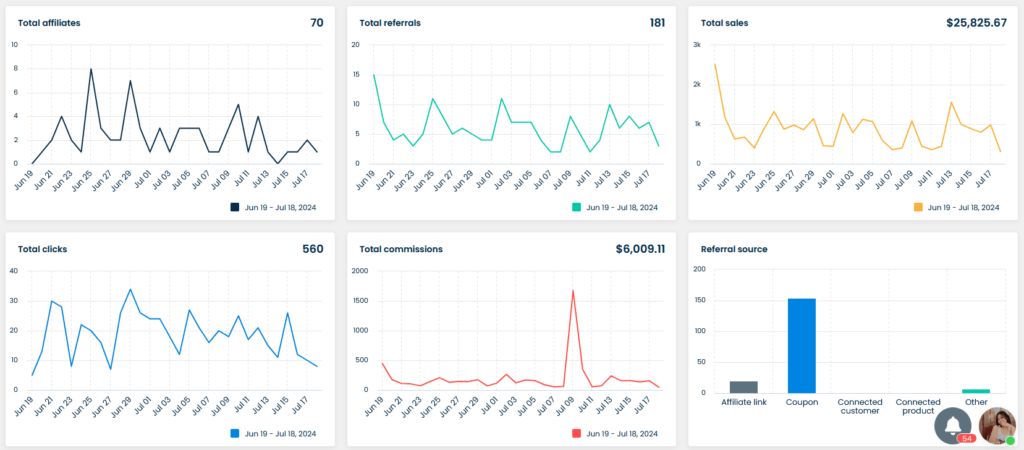
Using these insights, you can make smart changes to improve your campaign, such as:
- Reach out to partners who didn’t hit their goals. Offer help if needed.
- Adjust rewards based on performance to keep top affiliates engaged.
- Try different commission rates to see what works best.
Holbrook Pickleball is a great example of applying this tactic. They don’t just set sales targets and wait. They use UpPromote’s analytics dashboard to track their ambassadors’ sales closely.

When an ambassador does well, Holbrook sends gift packages using UpPromote’s gift feature. It is a thoughtful way to thank them for their dedication.
By watching real-time data, Holbrook can offer timely incentives, keeping affiliates motivated to promote their products. The outcome? Affiliate revenue increased by 86% in just one year.
“We look at the analytics section all the time, like every single day. It’s really useful and helps us a lot in making insightful decisions about what to do next.”
Olivia
Holbrook Pickleball Marketing Manager
Wrapping Up
Achieving success in affiliate marketing hinges on effectively tracking and analyzing key performance indicators (KPIs). By doing so, you can see how well your campaigns are doing and find ways to improve your strategies to get a better return on investment (ROI).
Think about your affiliate marketing goals and use our list of 20 key metrics to set clear KPIs for your campaign. Also, make sure to use the right tools and software to make tracking and analyzing easier.








